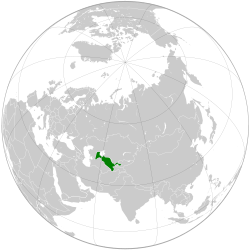 | |
| Country | Uzbekistan |
|---|---|
| Continent | Asia |
| NSN length | 9 [1] |
| Format | +998 BC XXXXXXX |
| Country code | +998 |
| International access | 00 |
| Long-distance | (none) |
The Uzbek telephone numbering plan describes the allocation of telephone numbers in Uzbekistan.
 | |
| Country | Uzbekistan |
|---|---|
| Continent | Asia |
| NSN length | 9 [1] |
| Format | +998 BC XXXXXXX |
| Country code | +998 |
| International access | 00 |
| Long-distance | (none) |
The Uzbek telephone numbering plan describes the allocation of telephone numbers in Uzbekistan.
Phone numbers typically have nine digits (except for emergency services and certain short codes) and are composed of a two-digit area code followed by subscriber number. No trunk prefix is used. [1]
The following are area codes and operator prefixes in Uzbekistan: [1]
| Code | Technology | Type | Locality or operator |
|---|---|---|---|
| 20 | mobile GSM | non-geographic | OQ (Beeline) |
| 33 | mobile GSM | non-geographic | Humans |
| 50 | mobile GSM | non-geographic | Ucell |
| 55 | VoIP | non-geographic | Uztelecom |
| 61 | fixed | geographic | Karakalpakstan (including Nukus) |
| 62 | fixed | geographic | Khorazm Region (including Urgench) |
| 65 | fixed | geographic | Bukhara Region (including Bukhara) |
| 66 | fixed | geographic | Samarkand Region (including Samarkand) |
| 67 | fixed | geographic | Sirdaryo Region (including Guliston) |
| 69 | fixed | geographic | Namangan Region (including Namangan) |
| 70 | mobile GSM | non-geographic | Uzmobile |
| 71 | fixed | geographic | Tashkent |
| 72 | fixed | geographic | Jizzakh Region (including Jizzakh) |
| 73 | fixed | geographic | Fergana Region (including Fergana) |
| 74 | fixed | geographic | Andijan Region (including Andijan) |
| 75 | fixed | geographic | Qashqadaryo Region (including Qarshi) |
| 76 | fixed | geographic | Surxondaryo Region (including Termez) |
| 77 | mobile GSM | non-geographic | Uzmobile |
| 78 | fixed | non-geographic | Various operators |
| 79 | fixed | geographic | Navoiy Region (including Navoiy) |
| 80 | mobile 5G-SA | non-geographic | Perfectum Mobile |
| 87 | mobile GSM | non-geographic | Mobiuz |
| 88 | mobile GSM | non-geographic | Mobiuz |
| 90 | mobile GSM | non-geographic | Beeline |
| 91 | mobile GSM | non-geographic | Beeline |
| 93 | mobile GSM | non-geographic | Ucell |
| 94 | mobile GSM | non-geographic | Ucell |
| 95 | mobile GSM / CDMA | non-geographic | Uzmobile |
| 97 | mobile GSM | non-geographic | Mobiuz |
| 98 | mobile CDMA | non-geographic | Perfectum Mobile |
| 99 | mobile GSM | non-geographic | Uzmobile |
International call prefix when dialling from Uzbekistan is 00, [1] having replaced the earlier prefix 8~10.